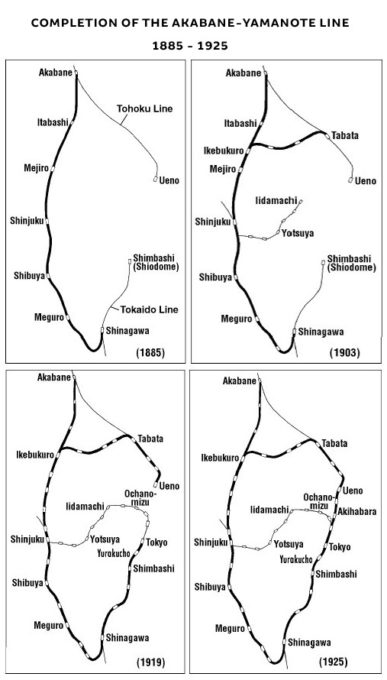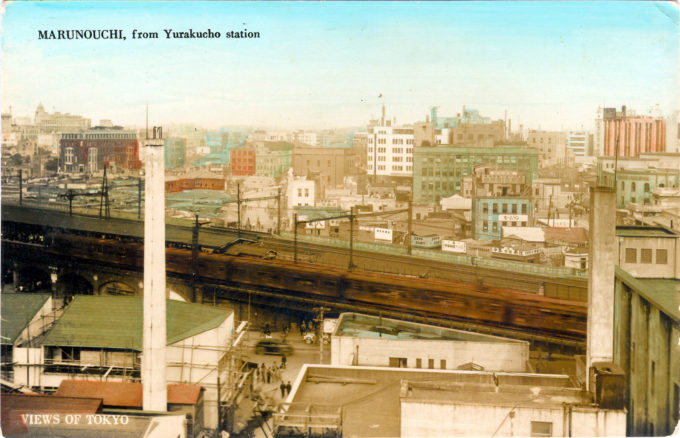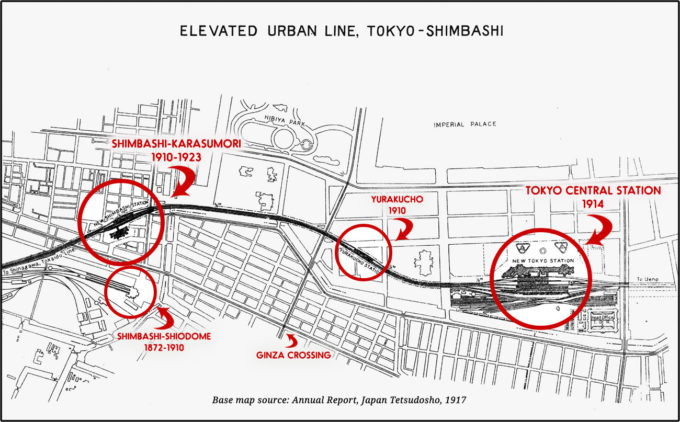![The Elevated Laiway [sic], Tokyo, c. 1910, at Yurakucho.](https://www.oldtokyo.com/wp-content/uploads/2016/03/elevated-railway-300-680x435.jpg)
The opening of Yurakucho Station, on June 25, 1910. The photographer is standing on the elevated right-of-way being constructed for later Tokaido Main Line express train track expansion north from Shimbashi-Kasumori to Tokyo’s new planned terminal, Tokyo Central Station, that would be completed in 1914.
See also:
Tokyo Station, 1914-1940.
Shimbashi Station (Kasumori), c. 1910-1923.
“The Overhead Railway
“On the 25th ult. the section of the over-head railway in Tokyo, from Yurakucho to Karasumoricho [Shimbashi], was opened to traffic. Passengers are thus enabled to travel from Yurakucho to Uyeno by this line, but to do so they have to make a wide circuit via Meguro and Shinjuku. The scale of fares fixed by the railway authorities is interesting.
Yamanote née Akabane Line (solid black line) history, 1885-1925, depicting the construction stages and the eventual completion of Tokyo’s famous “circle” commuter line – but not until 1925.
“The distance from Yurakucho to Shinagawa can be travelled for 4 sen, and within that distance there are two intermediate fares of 2 sen and 3 sen. From Shinagawa to Meguro an addition of 2 sen is charged, and from Meguro to Shinjiku an additional 4 sen, after which a 10 sen ticket carries the traveller all the way round to Uyeno.
“The portion of this line which actually consists of overhead railway is from Yurakucho to Hamamatsucho. This overhead railway was planned in 1896, under the guidance of a German engineer, but work was not commenced until the year 1900, and thereafter a serious interruption was caused by the [Russo-Japanese] war. In 1906 the building was resumed and, as stated above, the southern section has now been completed. The line is supported throughout on brick arches. The road bed is 19 feet above the streets and the width of the track is 51 feet.
“Of course the cost has been very great. Taking everything into consideration the money expended is said to have averaged 60 yen per foot, and the total outlay on the above section has been 5 million yen.
“When the Karasumoricho station is built, the present Shimbashi terminus [at Shiodome] will be converted into a goods station only, and a large new station will be built at Shinagawa on reclaimed land for purposes of passengers and goods; further, the big factories and work shops at Shimbashi will be moved to Oimura, in the Omori suburb of Tokyo. The service of trains is to be one every fifteen minutes.”
– Japan Daily Mail, July 2, 1910




